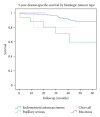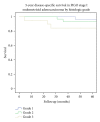Endometrial cancer patients: a cohort previous to changes in tumour behaviour and treatment strategies
- PMID: 22229100
- PMCID: PMC3246774
- DOI: 10.5402/2011/950460
Endometrial cancer patients: a cohort previous to changes in tumour behaviour and treatment strategies
Abstract
Nowadays, the incidence of endometrial cancer is rising, especially of high-grade endometrial tumours. Recently, the FIGO classification of endometrial cancer has changed worldwide. Besides that, treatment strategies are changing. The purpose of this study was to analyse the adherence to the national guidelines of cancer treatment and to analyse patterns of disease relapse and survival. We focused on a group of patients (n = 191) with endometrial cancer, in a time period in which new treatment strategies are not yet completely implemented. Because of multiple upcoming changes in patient characteristics, tumour classification, as well as treatment regimens, a more heterogeneous cohort of patients diagnosed with endometrial cancer will appear. From now on, all those changes will have their effects on the followup of conventional endometrial cancer treatment. In our opinion, it is, therefore, valuable to have the current, more homogenous, cohort clearly described.
Figures



Similar articles
-
High-Grade Endometrial Cancer-Behaviour and Outcomes at a Tertiary Cancer Centre.Indian J Surg Oncol. 2019 Dec;10(4):662-667. doi: 10.1007/s13193-019-00970-1. Epub 2019 Aug 21. Indian J Surg Oncol. 2019. PMID: 31866730 Free PMC article.
-
Does the use of the 2009 FIGO classification of endometrial cancer impact on indications of the sentinel node biopsy?BMC Cancer. 2010 Aug 30;10:465. doi: 10.1186/1471-2407-10-465. BMC Cancer. 2010. PMID: 20804553 Free PMC article.
-
Dynamic contrast-enhanced ultrasound improves diagnostic performance in endometrial cancer staging.Ultrasound Obstet Gynecol. 2020 Jul;56(1):96-105. doi: 10.1002/uog.21885. Ultrasound Obstet Gynecol. 2020. PMID: 31647145
-
[Current TNM/FIGO classification for cervical and endometrial cancer as well as malignant mixed müllerian tumors. Facts and background].Pathologe. 2011 May;32(3):239-43. doi: 10.1007/s00292-010-1273-6. Pathologe. 2011. PMID: 20084383 Review. German.
-
Endometrial Carcinoma Diagnosis: Use of FIGO Grading and Genomic Subcategories in Clinical Practice: Recommendations of the International Society of Gynecological Pathologists.Int J Gynecol Pathol. 2019 Jan;38 Suppl 1(Iss 1 Suppl 1):S64-S74. doi: 10.1097/PGP.0000000000000518. Int J Gynecol Pathol. 2019. PMID: 30550484 Free PMC article. Review.
Cited by
-
Classification Systems of Endometrial Cancer: A Comparative Study about Old and New.Diagnostics (Basel). 2021 Dec 24;12(1):33. doi: 10.3390/diagnostics12010033. Diagnostics (Basel). 2021. PMID: 35054199 Free PMC article.
References
-
- Parkin DM, Bray F, Ferlay J, Pisani P. Global cancer statistics, 2002. Ca-A Cancer Journal for Clinicians. 2005;55(2):74–108. - PubMed
-
- Dutch cancer registration, 2008, http://www.ikcnet.nl/uploaded/docs/Landelijk/cijfers/incidentie%202008/A....
-
- Dutch cancer registration, 2008, http://www.ikcnet.nl/uploaded/docs/Landelijk/cijfers/incidentie%202008/B....
-
- Uharček P. Prognostic factors in endometrial carcinoma. Journal of Obstetrics and Gynaecology Research. 2008;34(5):776–783. - PubMed
-
- Kosary CL. FIGO stage, histology, histologic grade, age and race as prognostic factors in determining survival for cancers of the female gynecological system: an analysis of 1973–87 SEER cases of cancers of the endometrium, cervix, ovary, vulva, and vagina. Seminars in Surgical Oncology. 1994;10(1):31–46. - PubMed
LinkOut - more resources
Full Text Sources

